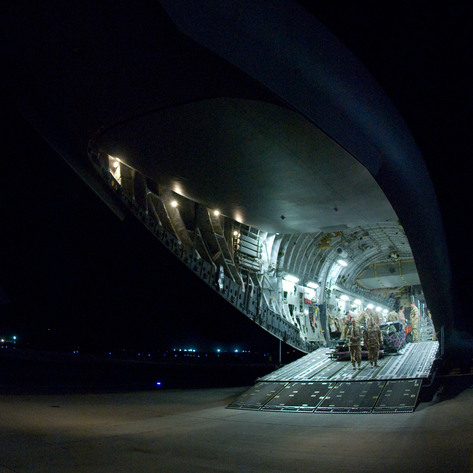Art in the Danger Zone (2008)
Writer: Michaela Crimmin, David CotterrellEditor: Phil Pemberton
Publisher: RSA / Wardour
ISBN: 0958-0433 RSA Journal, Vol. CLIV, No.5533, Spring 2008
Pages: 50pp (article pages 34-39) (Colour)
Commissioned photo-essay for RSA Journal.
Artists are providing new perspectives on the subject of war, says RSA head of arts Michaela Crimmin as she explores the history of art and conflict and introduces artist David Cotterrell's RSA residency in Kabul. The accompanying photo essay is the result of his recent stay with British troops in Afghanistan.
Abstract: David Cotterrell: an artist's view
This is my first attempt to rationalise an immersive and humbling experience. For the majority of November 2007, I lived in locations in the Helmand province of southern Afghanistan among doctors, soldiers and marines. I was hosted by the Royal Army Medical Corps and later by the Royal Marine Commandos. I had been sent to this strange and contradictory environment with the support of the Wellcome Trust with an agenda to explore the ethically challenging relationship between war and medicine.
Stepping off the back of a Hercules into the red glow of the dust-covered sunset at Camp Bastion, I had never been further out of my own context. I had never been a witness to a serious medical operation, and before my pre-deployment training a few weeks earlier, I had never visited a military base. Armed with a Geneva Convention civilian ID card, body armour, gas mask and dog-tags, I had wandered naively into an environment that had both a simplicity and complexity that soon contradicted all of my confident, cliched assumptions.
My role was unusual. While there is a British tradition of war artists, they are rare enough that each one has to renegotiate and define their relationship to the military. I had two initial challenges: I needed to explain my role to the community that I was temporarily part of, and perhaps more difficult, I had to justify and understand the rationale for my presence to myself. There is an accepted model for journalists, historians and military photographers in a warzone. Their presence is mediated and managed through established military structures. My presence was facilitated through the tolerance, understanding and goodwill of doctors and soldiers of the field hospital regiment. As an artist, my only justification for travelling to an environment such as this is to try to provide an independent and critical response. In such an immersive context, it is hard to be confident that this objectivity is maintained.
I adopted the role of photographer for two reasons. It allowed me to legitimately record the unfamiliar and at times incomprehensible experience in the hope of an abstracted future moment of analysis. However, the main reason was that it provided those around me with an explanation for my presence. As a photographer, I had a visible role and when surrounded by a community where everyone had a clear function, this was essential. I also felt compelled for the first time to write a journal. It is a rambling confessional, documenting my guilt and anxiety over my role. As my memory begins to attempt to simplify my journey into a coherent linear narrative, this detailed evidence enables a continuing reminder of the moral and emotional complexity of the experience. I was an observer and a participant, neither military or civilian. While I never carried or fired a weapon, I am complicit in the Afghan conflict through my presence. I have returned to England with a surprising shift in my perception of the military. I have seen some of the diversity that is encompassed within an apparently uniform community. I saw great compassion, humour and kindness. I saw haunting images of the brutal results of war on soldiers, insurgents and civilians.
Despite travelling to areas near the frontline such as Sangin, where the boundary between military and civilian territory is measured in yards rather than miles, I realised that what I was being allowed a privileged insight into was not a nation, but an institution. I saw Afghanistan across sandbags and wire, through the filter of military conflict. It was hard to be confident that I was ever seeing beyond the filter. The results of my journey are still to be clarified. The photographs may develop a life of their own. A small selection will soon return to Afghanistan by military transport. A more reflective response is being developed for exhibition near the end of this year at the Wellcome galleries. I feel a conflict between my loyalty to those who trusted me enough to allow me to witness their suffering and their work, and my continuing desire to feel confident that as an artist, I have managed to retain my autonomy.
This is a great motivation for my return to Afghanistan. I am grateful for the rare opportunity provided by the RSA to reflect on this beguiling and beautiful country from an alternate perspective. The framework of this residency within the RSA's Arts & Ecology programme presents particular intellectual challenges. Sustainability as a term has a very specific interpretation in areas enduring conflict. It was striking when living in military outposts how the amount of material consumed and waste produced became extremely apparent. When food is delivered by helicopter and water by convoy, the supply network that is discreetly embedded within more stable societies is exposed and the volume of imported material needed to maintain life can be witnessed.
I have an interest in developing new dialogues that may act as counterpoints to my existing understanding of Afghanistan. I aspire to understand the privileges and limitations inherent in my experience with the military and to reflect the contradictions possible within a nation experiencing both bloody conflict and embryonic reconstruction.
The full article may be downloaded as an illustrated pdf file here.
Share:
Twitter / Facebook / Pinterest



